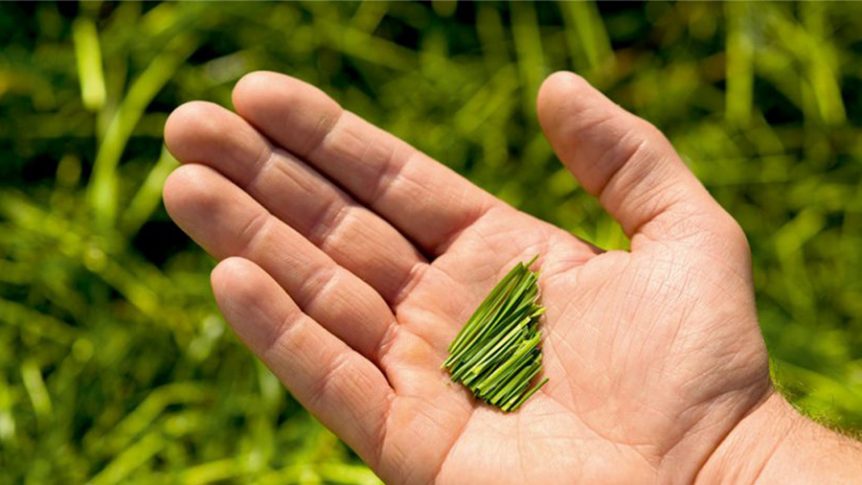Mulch lawn clippings and leaves for better lawns. Mulching returns valuable nutrients and organic matter to soil and can even help prevent weeds.
Who loves lugging a heavy bag of lawn clippings to the compost pile or yard waste bin, or endlessly raking leaves in the fall? Pretty much nobody, that’s who. Fortunately, for the sake of aching backs and nutrient-hungry lawns, it’s best to forgo the bag and opt to mulch lawn clippings and leaves instead.
Each little bit of plant material is full of nutrients and being organic matter, when left in place, can improve the overall health of the soil which in turn, better supports the turf and potentially decrease inputs.
“In the lawncare industry we’re realizing that rather than feed the lawn synthetically with fertilizers we can choose to do it more organically by mulching grass clippings and leaving them on the lawn to sift in,” says Richard Hentschel, University of Illinois horticultural extension educator. “Leaving clippings on the lawn provides the equivalent of 1 pound of nitrogen per 1,000 square feet of lawn. That’s nitrogen you didn’t have to buy and apply.” Removing the clippings means also removing those nutrients from the system.
Besides nutrients, clippings return carbon to the soil, which helps build soil organic matter by feeding the microflora that decomposes that organic matter. Soil organic matter (SOM) is measured as a percentage of organic matter in the soil and is the primary indicator of soil health and therefore the health of the lawn growing in the soil. The higher the percentage of SOM, the more nutrients and water the soil can retain.
“Every 1 percent of SOM holds 1/3 gallon of water per cubic foot of soil,” Hentschel explains. “So, a soil with a fairly good measurement of 3 percent SOM can hold as much as 1 gallon of water per cubic foot.” The ability to hold more water means more of the water applied to the soil through irrigation or falling on the lawn as rain will stay put and turf will be more resistant to swings in temperature and drought conditions.
“SOM also is Mother Nature’s slow release fertilizer. It’s not just the usual nitrogen, phosphorus and potassium either, it’s all 16 of the nutrients essential for plant growth,” Hentschel says. Constantly removing lawn clippings and other organic matter resulting in decreasing levels of SOM and lawns will become increasingly dependent on the application of synthetic fertilizers.
Plan Ahead
While lawns benefit from clippings, they don’t want to be smothered by them. Using best mowing practices can leave grass room to breathe and looking as clean as it would with bagging. The key is to mow with sharp blades and frequently enough that no more than 1/3 of the plant tissue is removed per cutting. This will result in less plant material for the lawn to reincorporate per pass.
“If you mow often with a sharp mower blade, even a conventional mower — as opposed to a mower designed specifically for mulching — will cut the grass up fine enough for it to sift back into the standing grass and break up quickly releasing nutrients to the soil and growing grass as it decomposes,” Hentschel says.
It may be a relatively simple task to stay ahead of grass to get a nice fine mulch that disappears quickly into the lawn, but what about leaves in the fall? Hentschel says to go ahead and mulch them, too. Leaves should be mowed frequently as they fall. To ensure finely parsed leaves that will move into the thatch layer more quickly, it may be necessary to make two or more passes with the lawnmower per mowing. When more leaves fall, simply keep making passes to chop up the material and help speed the composting process.
Hentschel says the leaf residue will work its way into the soil taking valuable nutrients with them and creating a barrier that can help control weeds. With multiple years of mulching leaves, which returns more nutrients to the soil through the extra organic matter, lawns may not need as much fertilizer in the spring. And because the leaf residue covers up bare spots where weeds can gain a foothold, it’s possible over time to see fewer dandelions and crabgrass issues after multiple years of mulching.
No raking, no lugging, less fertilizer, more efficient water use, and fewer weeds—for once, the easy choice is also the best choice. Go ahead and leave the mower bag in the shed if you’re so inclined, and leave the organic matter right where it belongs, on the lawn.
Helpful links:

